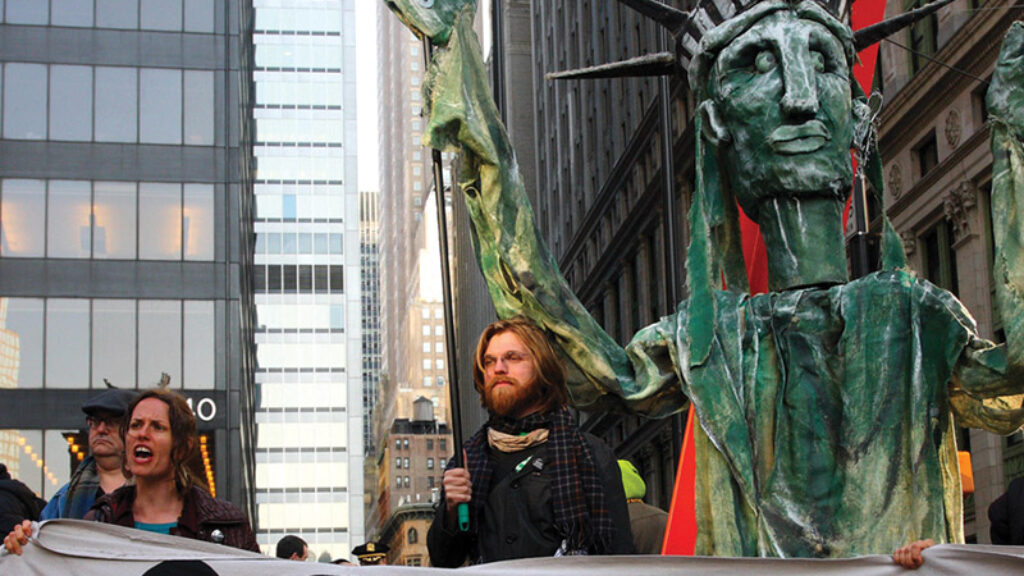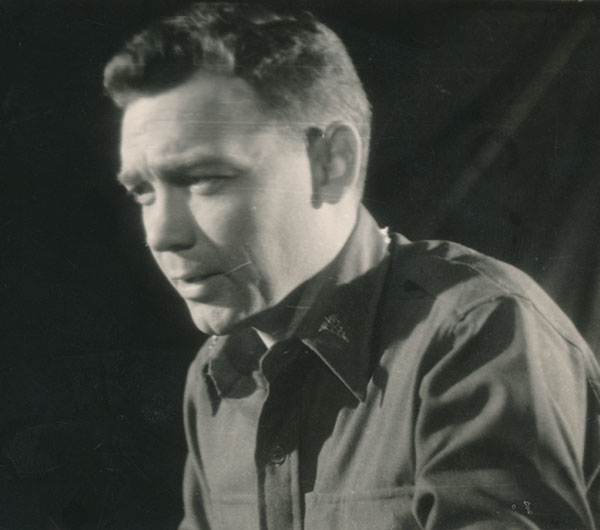Psychology at Nuremberg
On May 10, 1941, Rudolf Hess, the deputy führer of Nazi Germany, surreptitiously piloted a plane from Augsburg, Germany to a small homestead in Scotland. Upon being discovered by a farmer, he exclaimed, “I have an important message for the Duke of Hamilton.” Hess had come to make a peace offer to Britain without Hitler’s knowledge, reasoning that Germany’s true enemy was the Soviet Union. It was so odd and surprising that a joke began to make the rounds: Churchill, cigar in mouth, said to Hess, “So you’re the madman are you?” And Hess replied, “Oh, no, only his deputy.”

This joke, popular in Germany, reflected a prevalent view: Only a psychopath would appoint a deputy like Hess; only a madman would attempt to conquer the world. This conclusion was shared by President Roosevelt, who called Hitler “a nut” and a “wild man.” Indeed, officials in the United States and Great Britain committed significant resources to exploring Nazi psychiatric pathology during the war. For instance, Walter Langer, an American psychoanalyst, studied propaganda and Hitler’s psyche under the auspices of the American Office of Strategic Services (OSS).
Fascination with the Nazi mind persisted into the Nuremberg trials of November 1945, where chief prosecutors and judges from Great Britain, France, the United States, and the USSR put the captured Nazi high command on trial for war crimes, crimes against humanity, wars of aggression, and crimes against peace. At the trials, psychologists and psychiatrists furiously rushed to understand their high-profile Nazi prisoners. Mental health experts could finally examine and interview the alleged madmen up close and answer the question, were the Nazis insane?
In The Anatomy of Malice: The Enigma of the Nazi War Criminals, Joel Dimsdale, a professor emeritus of psychiatry at the University of California, San Diego, tells the story of Douglas Kelley, a U.S. army psychiatrist, and Gustave Gilbert, a psychologist, who interviewed the prisoners about the war, politics, family life, and the Nazi rise to power. Kelley and Gilbert also gave their prisoners Rorschach exams, presenting them with the famous ink-blot cards and asking the standard questions, “What does this card remind you of?” and “Can you point out what parts of the card made you say that?” At the time, these tests were considered to be among the most valuable of psychodiagnostic exams. For instance, patients who saw more movement in the pictures were thought more likely to be creative and intelligent. Subjects who saw plants and nature within the blots were evaluated as more “isolated interpersonally.”
With Rorschach results and interview notes in hand, did Kelley and Gilbert solve the enigma of Nazi pathology, or, at least, provide the materials for such a solution? Or, to put the question even more modestly, what did their investigations teach us about what Dimsdale calls “the anatomy of malice”?
Of the more than 20 defendants at the first Nuremberg trial, Dimsdale concentrates on four “whose malice,” he writes, “was rooted in different soils”: Robert Ley, Julius Streicher, Rudolf Hess, and Hermann Göring.
Ley, who was the head of the German Labor Front, created a slave labor force to support the Nazi war effort, and his view of Jews was uncompromising:
Degenerate to their very bones, . . . nauseatingly corrupt, and cowardly like all nasty creatures—such is the aristocratic clique which the Jew has sicked [sic] on National Socialism. . . . We must exterminate this filth, extirpate it root and branch.
This anti-Semitism was matched only by his impulsivity. An alcoholic, he drove the Duke and Duchess of Windsor around Munich while drunk, eventually plowing through locked gates and nearly running over several workers. At a dinner party, he ripped his second wife’s clothing off so that the guests could admire her body. Dr. Kelley wrote that Ley “was totally unable to carry on a coherent conversation” without shouting and ranting. Surprisingly enough, Ley requested “if at all possible . . . to have a Jewish person as my defense counsel.” Before he could be sentenced, however, he had hung himself with his towel, stuffing his underpants into his mouth to mute any involuntary sounds he might make.
Kelley’s psychiatric assessment of Ley was fairly straightforward: He had poor judgment and was emotionally unstable, likely due to frontal lobe damage from several accidents. When Ley’s brain was shipped to the Armed Forces Institute of Pathology in Washington, D.C., Dr. Webb Haymaker, a neuropathologist, did find atrophy of the frontal lobes and “chronic encephalopathy of sufficient duration and degree to have impaired Dr. Ley’s mental and emotional faculty,” though he thought that these were more likely to have been due to alcohol abuse than trauma.
Kelley and Gilbert came to different conclusions about Julius Streicher, the founder and publisher of Der Stürmer, the virulently anti-Semitic Nazi publication. Streicher refused every attorney offered to him because, as Dimsdale explains, “all the names on the list sounded Jewish and he wanted an anti-Semite as his defense counsel.” And yet, three psychiatrists from Russia, France, and the United States found him fit for trial:
It being the unanimous conclusion of the examiners that Julius Streicher is sane, he is for that reason capable of understanding the nature and quality of his acts during the period of time covered by the Indictment.
Gilbert concluded that Streicher was paranoid and had an “apathetic obsessive quality.” Kelley thought that Streicher was essentially rational but obsessed by the Jewish question: He “had a systemized series of beliefs . . . which were founded purely on his own emotions and prejudices and not on known facts.” As for Streicher’s Rorschach, it merely revealed, according to Kelley, a normal personality with strong markers of depression.
Unlike Streicher, Rudolf Hess, Hitler’s deputy who made that strange and ill-advised sojourn to Great Britain, befuddled the psychiatrists. Throughout his imprisonment he complained of insomnia, constipation, and an upset stomach, though physicians could find no organic cause for his complaints. Paranoia gripped the prisoner as well. He thought his captors had drugged his cocoa and injected poison into his apples.
Hess also claimed to have lost his memory. An international team of seven physicians, including neurologists, internists, psychoanalysts, and Winston Churchill’s personal doctor, came to examine Hess to evaluate his fitness for trial. The committee found that Hess was indeed psychologically fit for trial: “Hess is not insane, has no disorder of consciousness, understands the nature of the proceedings against him . . . A part of the memory loss is simulated.” During a hearing on his fitness to stand trial, the defendant proved the physicians right, standing up and shouting, “Henceforth my memory will again respond to the outside world. The reasons for simulating loss of memory were of a tactical nature. Only my ability to concentrate is, in fact, somewhat reduced. But my capacity to follow the trial, to defend myself, to put questions to witnesses, or to answer questions myself is not affected thereby.”
Kelley, unsure of what to make of Hess, wrote both that he had “no evidence of psychopathology” and that he was “insane.” He concluded that “diagrammatically, if one considers the street as sanity and the sidewalk as insanity, then Hess spent the greater part of his time on the curb.” Gilbert, too, had a difficult time assessing Hess. The Rorschach test didn’t make matters any clearer. In Kelley’s interpretation, Hess was competent with no evidence of psychopathology, but he added that Hess suffered from a “basic paranoid personality.”
Hermann Göring was a more straightforward patient. As commander of Germany’s air force, the Luftwaffe, the famous WWI pilot threw lavish parties at his mansion with pet lions, miniature airplanes, and cowboy and Indian movies. When he arrived at Nuremberg as a prisoner, he managed to bring along twenty thousand paracodeine pills, semi-synthetic opioid painkillers, to feed his addiction. Göring’s oddities didn’t end there. He was just as capricious with his racial views. When he appointed a field marshal who allegedly had some Jewish ancestry, Göring said, “In Germany, a Jew is whoever I say is a Jew.” He told Dr. Leon Goldensohn, another psychiatrist who interviewed him during the trials, “If I really felt that the killing of Jews meant . . . winning of the war, I would not be too bothered by it . . . I revere women and I think it unsportsmanlike to kill children . . . [I]f I had found out what was going on regarding the mass murders, it would simply have made me feel bad and I could do very little to prevent it anyway.”
Kelley and Gilbert “agreed that Göring was venal, corrupt, and brutal.” Gilbert described him as an “aggressive psychopath with an insatiable lust for power, titles, wealth, food, . . . and ostentatious display, ready to murder, steal, or stage frameups to gain his ends; the camouflage of the amiable extrovert and humorist.” And the Rorschach tests? According to Kelley, they revealed Göring’s intelligence, aggression, ambition, and egocentricity. Gilbert interpreted the test slightly differently, finding Göring to be of average intelligence and a coward in spite of his bravado and aggression.

Dimsdale admits that “Kelley and Gilbert spoke with great assurance, ignoring the fact that they were extrapolating on the basis of a small sample.” This is not to speak of the fact that these members of the Nazi high command were imprisoned, demoralized, and on trial for their lives. Under such harrowing circumstances any clear appraisal of a patient’s psychiatric condition is difficult. Nor can one extrapolate from members of the Nazi high command to other perpetrators, such as the concentration camp guards who corralled Jews to their deaths or the soldiers in the field who massacred Jews, Eastern Europeans, and Soviet citizens.
Moreover, as Dimsdale demonstrates, psychiatry was a very different field in the 1940s than it is today. Freudian ideas, which now lie on the fringes of acceptability, still held sway in many circles. But even Freud’s ideas were not applied in a unified manner. “[E]xperts,” Dimsdale writes, “lacked a common psychiatric vocabulary in Nuremberg in 1945 and 1946.” Thus, even simply interpreting Kelley and Gilbert’s assessments can be confusing. Nor do the Rorschach tests help. In the 1970s, Dr. Molly Harrower, a revered Rorschach expert, took the Rorschachs performed on a group of Unitarian ministers and psychiatric outpatients and combined them with those from the Nazis. She then gathered 10 Rorschach experts, asking them to identify the Nazi responses. They couldn’t, and further studies did no better.
Finally, Kelley and Gilbert’s partnership was a “collaboration from hell.” When Kelley left Nuremberg, Gilbert accused him of stealing his notes. Meanwhile, Kelley was already negotiating with publishers to write a book about Nuremberg. When he wrote Gilbert asking for “more interviews and transcripts from the trial,” Gilbert declined. Kelley continued to promote himself upon his return to the United States, giving interviews to the gossip-hungry press about his experience with the Nazis. As Gilbert stewed, both worked on competing books and fought over the data, such as it was. Kelley threatened to sue Gilbert if he used Kelley’s Rorschach materials for a book, while Gilbert accused Kelley of doctoring the records. And so on.
Nevertheless, both Kelley and Gilbert believed they could make a broad psychosocial argument despite the limited sample size, inconclusive tests, infighting, and lack of clear standards and definitions. Kelley argued that “Nazism is a socio-cultural disease. I had at Nuremberg the purest known Nazi-virus cultures—22 flasks as it were—to study . . . They can be found anywhere in the country—behind big desks deciding big affairs.” Gilbert, conversely, found that the Nazis were not on the continuum of normal human behavior. They were, as Dimsdale puts it, in “a unique category of psychopathology.”
According to Dimsdale, Kelley’s idea that there is darkness in every person and Gilbert’s conclusion that the Nazis had a unique darkness were “both right.” Nonetheless, as his own careful study shows, there is no psychiatric trend that stands out among the defendants at Nuremberg. Thus, at the end of this fascinating, disturbing book, the reader is left with questions—enduring questions to be sure—but no answers. Is it possible that there is no unifying psychopathology, no unique anatomy of malice?
In The Nuremberg Interviews, the historian Robert Gellately reproduced Dr. Leon Goldensohn’s (Kelley and Gilbert’s colleague) interviews with the Nuremberg defendants, and the conversations are revealing. Walter Funk, the German minister of economics from 1937 to 1945, told Goldensohn that “there was too high a percentage of Jews in the law, in the theater, and in the economic and cultural life of our Reich . . . But I was not a radical. I did not foresee the mass murders.” Franz von Papen, Hitler’s ambassador to Austria, expressed similar views:
Hitler didn’t strive for the annihilation of the Jews . . . Hitler merely said at the beginning that Jewish influence was too great . . . You see, after 1918, when the war was lost, we had an influx of Jews from the East. This overflow was absolutely abnormal in Germany . . . We thought that this should be corrected.
Alfred Rosenberg, the German minister of the occupied territories, said that the Jews “spat at German culture” by controlling “the theater, publishing, the stores, and so on.” How bizarre that even as they stood before the gallows denying responsibility for the mass murders for which they were being tried, these men could not bring themselves to repudiate anti-Semitism’s most basic premise, that there was “a Jewish problem”!
Nazi Germany fell under the malignant grip of a political pathology, not a psychological one. In this respect it was extreme but hardly unique. After all, one can observe the pathology of anti-Semitism not only in a mid-century deputy führer, but in a modern-day liberal arts professor, a Middle Eastern religious fanatic, and members of the British Labour Party, to name just a few contemporary instances. This may not be the generalized anatomy of malice for which Dimsdale was searching when he undertook this study, but it is a specific contagion with a recognizable anatomy.
Suggested Reading

Intrigues and Tzuris
Have you seen the one about the Hasidic jewelers and the Albanian goons?

Hanukkah’s Confounding Miracle
How Hanukkah became a holiday of many miracles and none.

The Protocols of Neoliberalism
Baram’s characters are righteously indignant at the system and determined to bring it down.
Joseph Roth: Grieving for a Lost Empire
Always in flight, one of the world’s permanent transients, Joseph Roth (1894–1939) was a one-man diaspora. A drunk and a fantasist, he was also a marvelous writer whose work was bedizened with metaphor, laced with simile.

Comments
You must log in to comment Log In